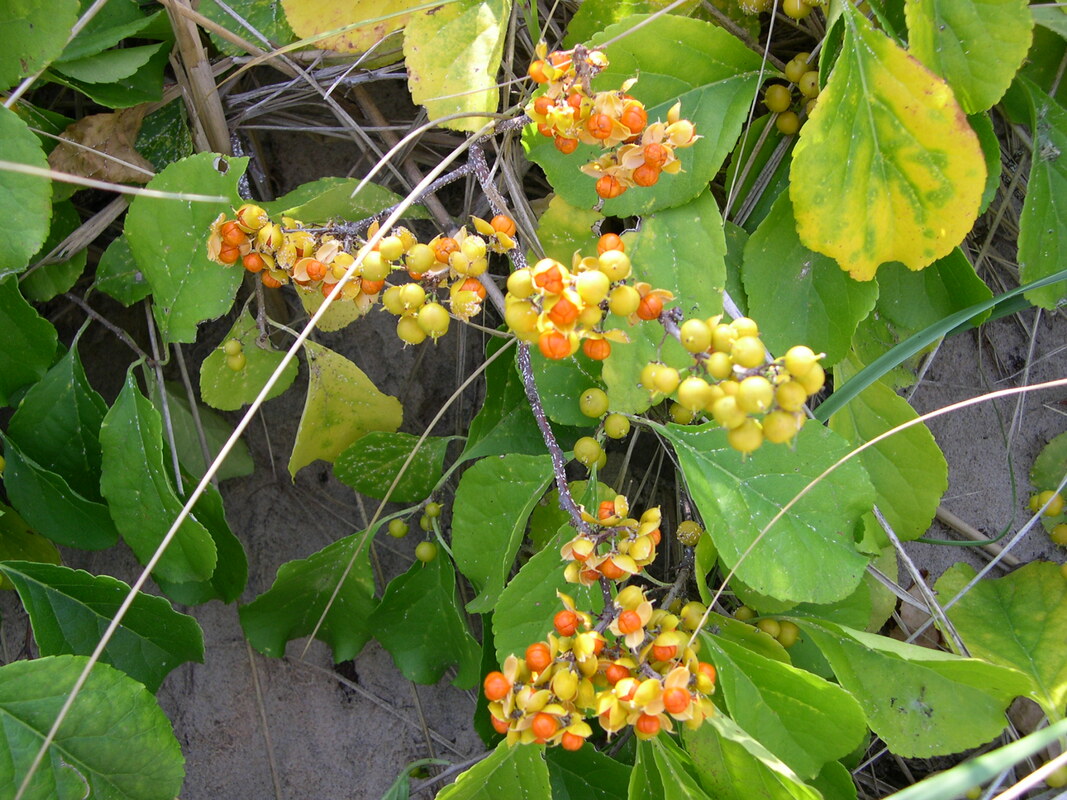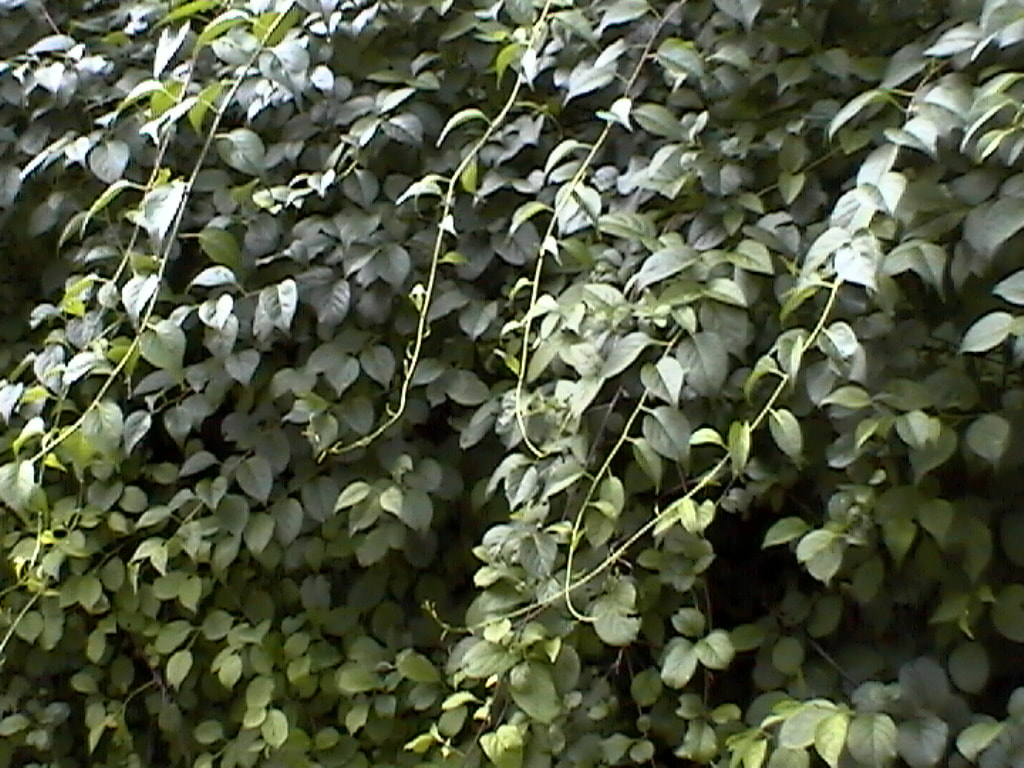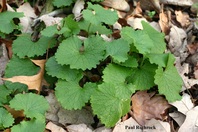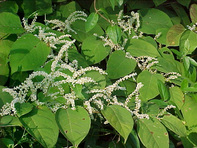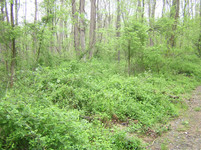The Worst Invasive Plants in Monroe County, Indiana
Based on a survey of MC-IRIS members, here are some of the worst invasive plants in Monroe County:
Asian Bittersweet
Celastrus orbiculatus
|
Status: scattered throughout Monroe County with some dense infestations.
Description:Woody, deciduous, climbing vine; leaves alternate, ovate to round, abruptly sharp-pointed and glossy; small greenish flowers occur in clusters in the leaf axils; yellow, papery coat surrounding capsule splits to reveal red-orange fruit in leaf axils in fall. American bittersweet (C. scandens) is similar but fruit reddish, with orange papery coats, and in terminal clusters, not in leaf axils. Threat: Climbs up and overtops trees, making them more vulnerable to windthrow; twining stems girdle or kill trees; hybridizes with native bittersweet, with the hybrids out-competing the native species. Alternatives: While American bittersweet can be found for sale, it is rarely actually the native bittersweet. It often turns out to be Asian bittersweet, and for this reason it is not recommended to purchase or plant American bittersweet. Instead, consider coral honeysuckle (Lonicera sempervirens) or crossvine (Bignonia capreolata). |
Asian Bush Honeysuckle
Lonicera maackii, L. morrowii, L. tatarica, and L. x bella
|
Status: common throughout Monroe County.
Description: These upright shrubs with arching branches are 6-15 feet tall. Each of these species has dark green egg-shaped leaves. They stand out in the understory of forests as the first shrubs to leaf out in the spring and the last to lose leaves in the fall. The paired, tubular flowers are white on Amur and Morrow honeysuckle and pink on Tartarian honeysuckle. Berries range from red to orange and are dispersed by birds. Threat: Rapidly forms a dense shrub layer that excludes native understory shrubs, decreases species richness, and reduces canopy tree growth. Alternatives: Dogwoods (Cornus racemosa, C. amomum, and C. sericea), chokeberry (Aronia melanocarpa), winterberry (Ilex verticillata), and northern arrowwood (Viburnum dentatum). |
Autumn Olive
Elaeagnus umbellata
|
Status: common throughout Monroe County.
Description: Large shrub or small tree with silvery foliage, up to 20’ tall. Leaves simple and alternate, silver‐gray on the underside, lance‐shaped or elliptic, with entire, wavy margins. Flowers tube‐shaped, borne in leaf axils, creamy white to light yellow. Blooms in late spring. Fruits small, fleshy, egg‐shaped, pink to red with silver spots. Threat: Rapidly invades and fills open fields; alters nutrient cycling by adding nitrogen to the soil, encouraging other invasions. Alternatives: Black haw (Viburnum prunifolium), dogwoods (Cornus racemosa, C. amomum, and C. sericea), and serviceberry (Amelanchier arborea). |
Garlic Mustard
Alliaria petiolata
|
Status: common throughout Monroe County.
Description: Herbaceous biennial with stems 2‐4’ tall. First‐year plants form a basal rosette that remains green through the winter. Second‐year plants produce one to several flowering stems. Basal leaves dark green, heart‐shaped, with large teeth. Stem leaves alternate, triangular, with large teeth, up to 3” across. Leaves and stems smell like garlic when crushed. Flowers small, white, 4‐petaled, and abundant; blooms throughout the spring. Fruits long, slender capsules with small, dark seeds. Threat: decreases native herbaceous cover by exuding antifungal chemicals that disrupt mycorrhizal fungal associations with native plants; alters habitat suitability for native insects, which may affect food availability for birds, mammals, and other animals. Alternatives: Celandine poppy (Stylophorum diphyllum), blue phlox (Phlox divaricata), and Jacob’s ladder (Polemonium reptans). |
Japanese Honeysuckle
Lonicera japonica
|
Status: common throughout Monroe County.
Description: Perennial, semi‐evergreen, woody vine. Young stems brown or red and usually pubescent; older stems woody and hollow. Leaves simple, opposite, oblong to oval, 1.5‐3” long, sometimes lobed, and may be covered with fine, soft hairs. Leaves persist on vine until mid‐winter. Flowers tubular and very fragrant, white to pink, turning yellow with age, and occurring in pairs at leaf axils. Blooms late spring to early summer. Purple to black berries produced in fall. Threat: grows over native vegetation, robbing it of light; can kill shrubs and young trees by girdling when vines twist tightly around stems. Alternatives: Virginia creeper (Parthenocissus quinquefolia), virgin’s bower (Clematis virginiana), American bittersweet (Celastrus scandens). |
Japanese Knotweed
Polygonum cuspidatum, also known as Fallopia japonica
|
Status: occasional throughout Monroe County, spreading from old plantings and along creeks.
Description: Arching herbaceous perennial, up to 10’ tall. Hollow, reddish, bamboo-like stems are smooth and stout, often persisting after plant dies back to the ground each year. Leaves alternate, egg‐shaped to almost triangular, 4‐6” long, 3‐4” wide. Dark green on upper surface, pale green on lower surface. Branched inflorescences of tiny, creamy white or greenish flowers emerge from leaf axils near the ends of stems. Blooms in late summer. Fruits are small, winged, and triangular with very small, shiny seeds. Threat: spreads vegetative to form dense thickets that suppress other vegetation in upland and lowland areas; can dominate along creeks, which leads to increased bank shear and erosion; decreases habitat for wildlife; rhizomes can damage building foundations and other structures. |
Japanese Stiltgrass
Microstegium vimineum
|
Status ‐ occasional throughout Monroe County, but rapidly spreading.
Description: Annual grass 1‐3’ (sometimes up to 5’) tall that grows in a branching, sprawling, mat‐like manner. Stems resemble a narrow, delicate bamboo. Leaves pale green, alternate, narrow, lance‐shaped, up to 3” long and lightly hairy. Pale, silvery stripe of reflective hairs along midrib of upper leaf surface. Turns yellow to orange in fall. Tiny flowers on slender stalks 1‐3” long, appearing in late summer. Each plant produces 100‐1,000 seeds. Threat: spread rapidly through many habitats; especially well adapted to low light conditions and thrives in forest understories, spreading rapidly to form extensive patches that displace native species. Deer may facilitate its invasion by feedng on native plants and avoiding the non‐palatable stiltgrass. |
Kudzu
Pueraria montana
|
Status ‐ five sites in Monroe County, all being controlled.
Description: Woody deciduous climbing vine. Leaves alternate, with three leaflets, each up to 4”across. Leaflets may be entire or deeply 2‐3 lobed with hairy margins. Flowers are 1.5” long, purple, fragrant and borne in long hanging clusters. Blooms in late summer. Fruits are brown, hairy pods. Threat: spreads rapidly by rhizomes and covers native vegetation, smothering it; can strangle shrubs and small trees by girdling when vines twist tightly around the stem; serves as alternate host for soybean rust. |
Multiflora Rose
Rosa multifora
|
Status: common throughout Monroe County.
Description: Thorny, thicket‐forming shrub with wide, arching or climbing canes and stiff, curved thorns. Can reach 10‐15’ tall and 9‐13’ wide. Leaves are alternate, pinnately compound with 5‐11 small sharply‐toothed oval leaflets. Pair of fringed stipules at the base of each leaf. Flowers are abundant, showy, fragrant, and white to slightly pink. Flowers are 0.5‐1.5" across and form a loose, branching inflorescence. Blooms mid‐ to late spring. Threat: extremely prolific and can form impenetrable thickets that exclude native plant species. |
Purple Wintercreeper
Euonymus fortunei
|
Status: common near Bloomington, occasional through the rest of Monroe County.
Description: Evergreen, clinging vine. Can form a dense ground cover or shrub to 3 feet in height, or climb 40‐70 foot high vertical surfaces with the aid of aerial roots. Stems are narrow, minutely warty, and have abundant rootlets or trailing roots. Leaves are dark green, shiny, and egg-shaped, from 1‐2 ½ inches long, with toothed margins and silvery veins, occur in pairs along the stems. Clusters of inconspicuous green-white flowers are produced on a long stalk in mid‐summer and are followed in the autumn by pinkish to red capsules that split open to expose seeds adorned with a fleshy orange seed coat, or aril. Threat: Outcompetes native vegetation by depleting soil moisture and nutrients, blocking sunlight, and by forming a dense vegetative mat that impedes the growth of seedlings of native species. Vines on trees continue climbing and can eventually overtop them, covering the leaves and preventing photosynthesis. |
Tree of Heaven
Ailanthus altissima
|
Status ‐ common near Bloomington, occasional through the rest of Monroe County
Description: Rapidly‐growing tree; mature trees can be 80' tall or more. Trees has smooth trunks with pale gray bark and light chestnut brown twigs. Leaves are alternate, pinnately compound, 1‐4' long. Composed of 11‐25 leaflets, which are entire with the exception of 1 to several glandular teeth near the base. Flowers are small, yellow‐green, with 5‐6 petals, in dense terminal inflorescences. Dioecious, blooms in late spring. Fruits are green turning to pink to tan, papery, in clusters; may remain on tree through winter. Threat: can quickly take over open sites and disturbed forests, able to outcompete native hardwoods. |
